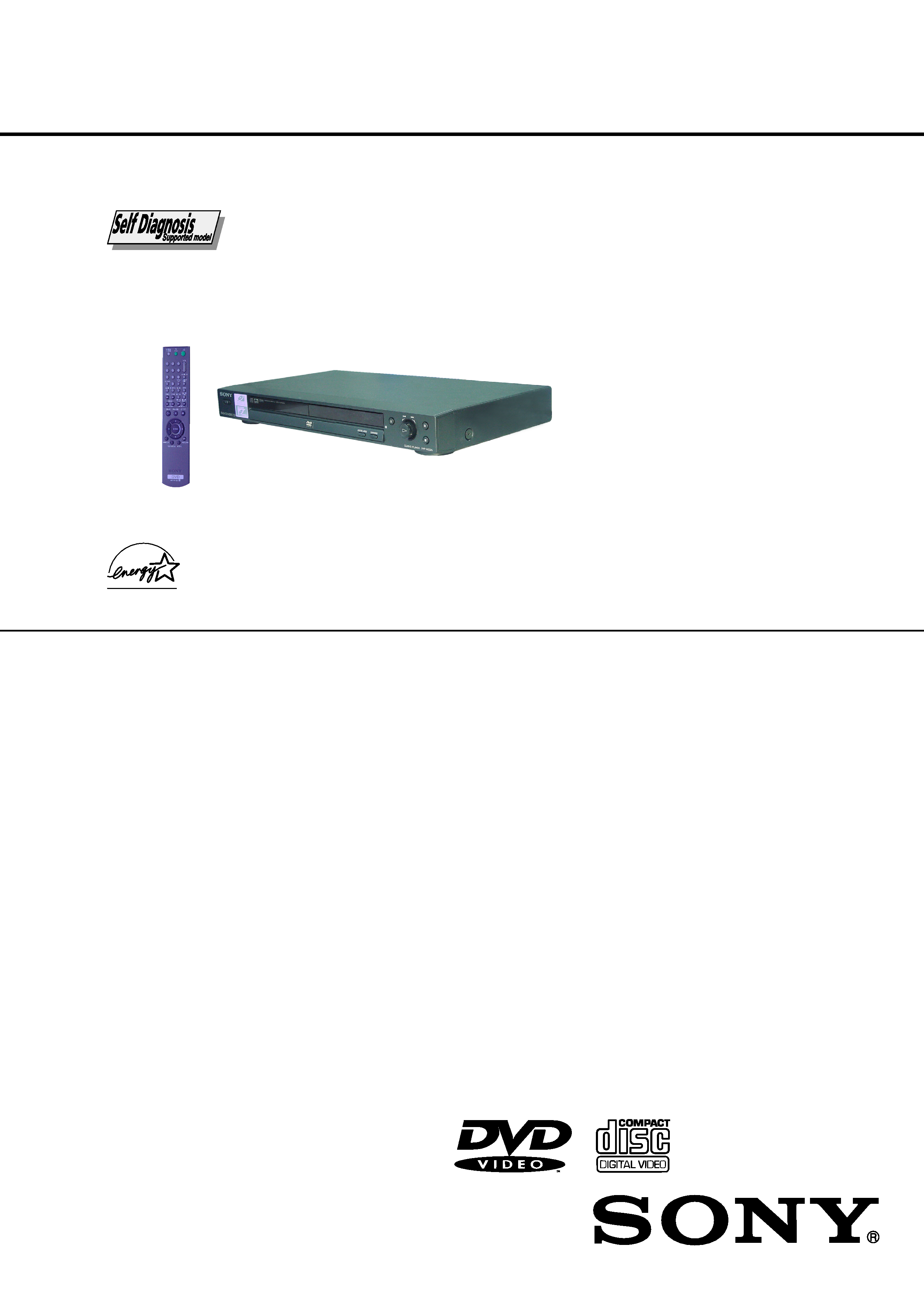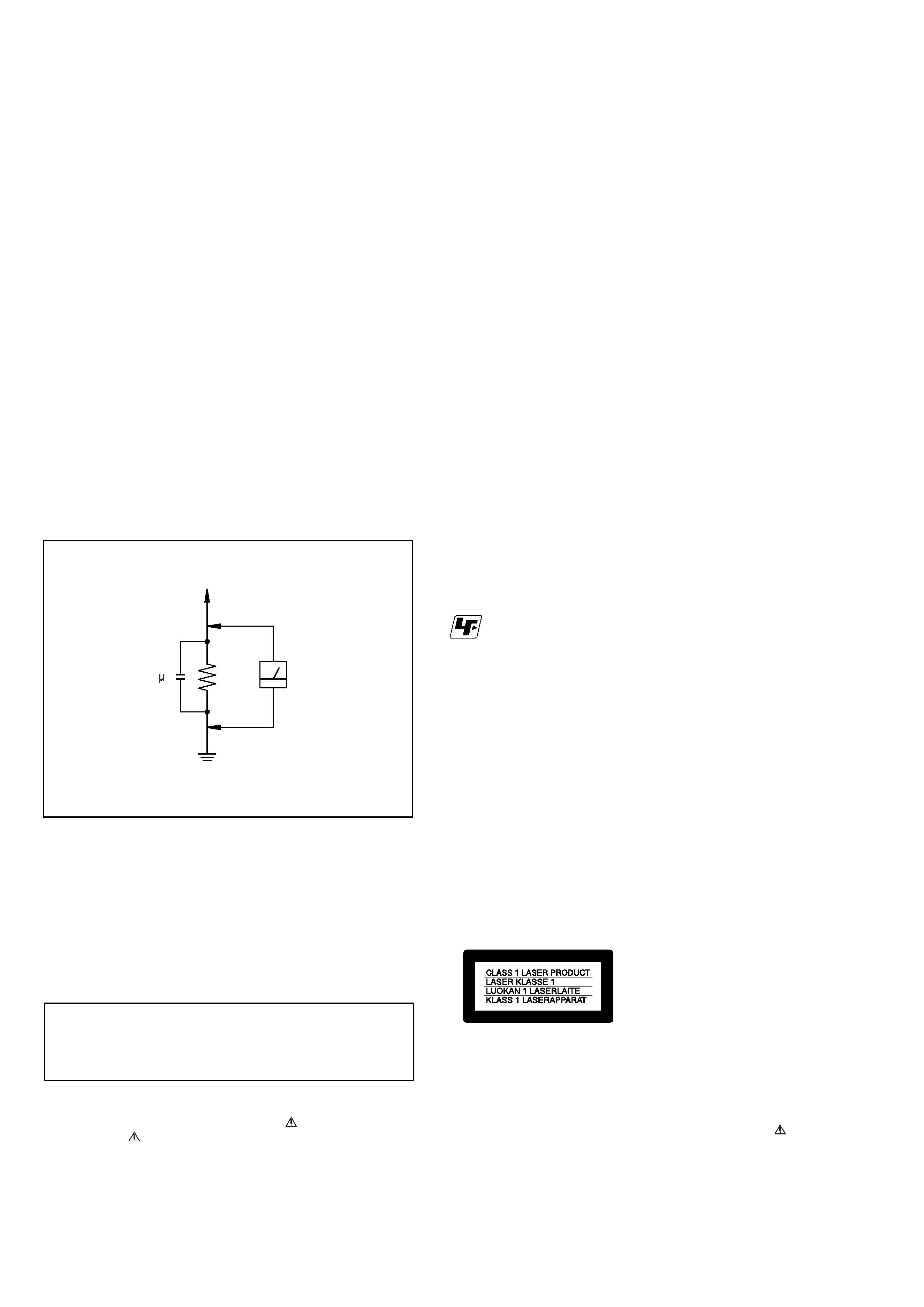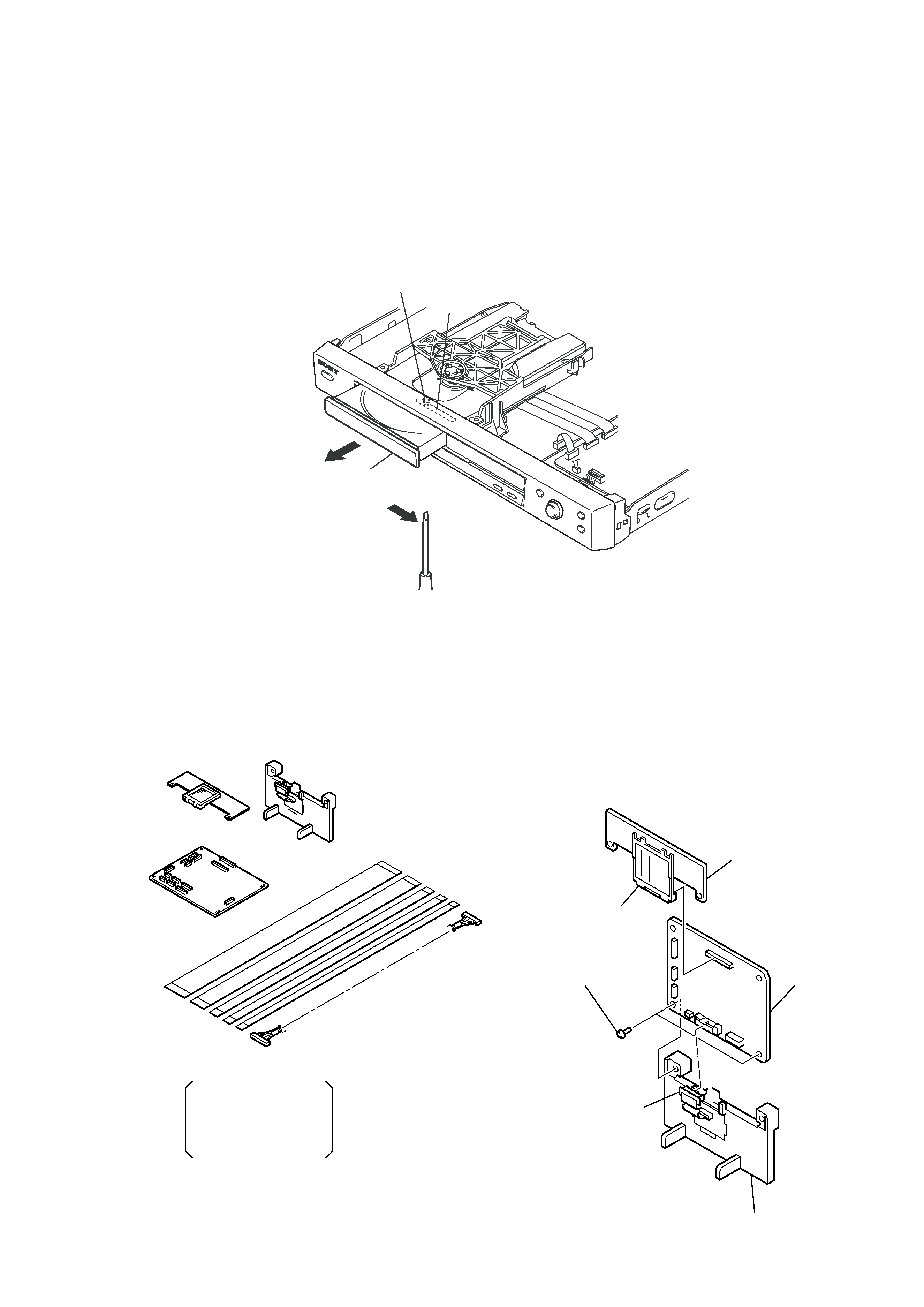
RMT-D152A/D156P/D157P/D152E/D153A/D158P
DVP-NS325/NS330/NS333/NS430/NS433/NS530/NS725P/NS730P
Photo : DVP-NS325
RMT-D152A
SERVICE MANUAL
CD/DVD PLAYER
System
Laser: Semiconductor laser
Signal format system: NTSC
Audio characteristics
Frequency response: DVD VIDEO (PCM
96 kHz): 2 Hz to 44 kHz (±1.0 dB)/
DVD VIDEO (PCM 48 kHz): 2 Hz to
22 kHz (±0.5 dB)/CD: 2 Hz to 20 kHz
(±0.5 dB)
Signal-to-noise ratio (S/N ratio): 115 dB
(LINE OUT (L/R) AUDIO jacks only)
Harmonic distortion: 0.003%
Dynamic range: DVD VIDEO: 103 dB/
CD: 99 dB
Wow and flutter: Less than detected
value (±0.001% W PEAK)
The signals from LINE OUT L/R
(AUDIO) jacks are measured. When you
play PCM sound tracks with a 96 kHz
sampling frequency, the output signals
from the DIGITAL OUT (COAXIAL) jack
are converted to 48 kHz sampling
frequency.
Outputs/Inputs (NS325)
Jack name: (Jack type/Output or
Input level/Load impedance)
Outputs (NS725P/NS530/NS730P/
NS330/NS333/NS430/NS433)
Jack name: (Jack type/Output level/
Load impedance)
LINE OUT (AUDIO): Phono jack/
2 Vrms/ 10 kilohms
DIGITAL OUT (OPTICAL): Optical
output jack/-18d Bm (wave length:
660 nm) (NS725P/NS530/NS730P/
NS430/NS433)
DIGITAL OUT (COAXIAL): Phono jack/
0.5 Vp-p/75 ohms (NS325/NS725P/
NS530/NS730P/NS330/NS333/
NS430/NS433)
COMPONENT VIDEO OUT (Y, PB, PR):
Phono jack/Y: 1.0 Vp-p/PB, PR:
0.65 Vp-p/75 ohms (NS325/NS725P)
COMPONENT VIDEO OUT (Y, PB/CB,
PR/CR): Phono jack/Y: 1.0 Vp-p,
PB/CB, PR/CR: 0.7 Vp-p/75 ohms
(NS730P)
COMPONENT VIDEO OUT (Y, CB/CR):
Phono jack/Y: 1.0 Vp-p, CB, CR:
0.7 Vp-p/75 ohms (NS530)
LINE OUT (VIDEO): Phono jack/
1.0 Vp-p 75 ohms (NS325/NS725P/
NS530/NS730P/NS330/NS333/
NS430/NS433)
S VIDEO OUT: 4-pin mini DIN/Y:
1.0 Vp-p, C: 0.286 Vp-p/75 ohms
(NS325/NS725P/NS530/NS730P/
NS330/NS333/NS430/NS433)
SPECIFICATIONS
General
Power consumption: 13 W/ 14 W
Dimensions (approx.): 430
× 55.5 ×
244 mm (17
× 2 3/16 × 9 5/8 in.)
(NS325/NS530/NS330/NS333)
430
× 55.5 × 237 mm (17 × 2 3/16 ×
9 3/5 in.) (NS430/NS433/NS725P/
NS730P)
Supplied accessories
See page 14 (NS325)
See page 15 (NS725P/NS530/NS730P/
NS330/NS333/NS430/NS433)
Specifications and design are subject to
change without notice.
ENERGY STAR is a U.S. registered
mark.
As an
ENERGY STAR Partner, Sony
Corporation has determined that this
product meets the
ENERGY STAR
guidelines for energy efficiency.
US Model
DVP-NS325/NS725P
Canadian Model
DVP-NS325/NS725P
PX Model
DVP-NS325/NS725P
E Model
DVP-NS325
Mexico Model
DVP-NS325
Brazilian Model
DVP-NS325
Argentina Model
DVP-NS325
AEP Model
DVP-NS330/NS333/NS430/
NS433
UK Model
DVP-NS330/NS430
Russian Model
DVP-NS330
Hong Kong Model
DVP-NS530/NS730P
Singapore Model
DVP-NS530/NS730P
Taiwan Model
DVP-NS530
Korea Model
DVP-NS530/NS730P
Saudi Arabia Model
DVP-NS530
Middle East Model
DVP-NS530/NS730P
Australian Model
DVP-NS530/NS730P
New Zealand Model
DVP-NS530/NS730P

2
SAFETY CHECK-OUT
1. Check the area of your repair for unsoldered or poorly-soldered
connections. Check the entire board surface for solder splashes
and bridges.
2. Check the interboard wiring to ensure that no wires are "pinched"
or contact high-wattage resistors.
3. Look for unauthorized replacement parts, particularly transis-
tors, that were installed during a previous repair. Point them out
to the customer and recommend their replacement.
4. Look for parts which, though functioning, show obvious signs
of deterioration. Point them out to the customer and recommend
their replacement.
5. Check the line cord for cracks and abrasion.
Recommend the replacement of any such line cord to the cus-
tomer.
6. Check the B+ voltage to see it is at the values specified.
7. Check the antenna terminals, metal trim, "metallized" knobs,
screws, and all other exposed metal parts for AC leakage. Check
leakage as described below.
WARNING!!
WHEN SERVICING, DO NOT APPROACH THE LASER EXIT
WITH THE EYE TOO CLOSELY. IN CASE IT IS NECESSARY TO
CONFIRM LASER BEAM EMISSION, BE SURE TO OBSERVE
FROM A DISTANCE OF MORE THAN 25 cm FROM THE SURFACE
OF THE OBJECTIVE LENS ON THE OPTICAL PICK-UP BLOCK.
CAUTION:
The use of optical instrument with this product will increase eye
hazard.
CAUTION
Use of controls or adjustments or performance of procedures
other than those specified herein may result in hazardous radiation
exposure.
SAFETY-RELATED COMPONENT WARNING!!
COMPONENTS IDENTIFIED BY MARK
OR DOTTED LINE
WITH MARK
ON THE SCHEMATIC DIAGRAMS AND IN
THE PARTS LIST ARE CRITICAL TO SAFE OPERATION.
REPLACE THESE
COMPONENTS WITH
SONY
PARTS
WHOSE PART NUMBERS APPEAR AS SHOWN IN THIS
MANUAL OR IN SUPPLEMENTS PUBLISHED BY SONY.
After correcting the original service problem, perform the following
safety checks before releasing the set to the customer:
LEAKAGE TEST
The AC leakage from any exposed metal part to earth ground and
from all exposed metal parts to any exposed metal part having a
return to chassis, must not exceed 0.5mA (500 microampers).
Leakage current can be measured by any one of three methods.
1. A commercial leakage tester, such as the Simpson 229 or RCA
TW-540A. Follow the manufacturers' instructions to use these
instruments.
2. A battery-operated AC milliammeter. The Data Precision 245
digital multimeter is suitable for this job.
3. Measuring the voltage drop across a resistor by means of a
VOM or battery-operated AC volmeter. The "limit" indication
is 0.75V, so analog meters must have an accurate low voltage
scale. The Simpson 250 and Sanwa SH-63Trd are examples of
a passive VOM that is suitable. Nearly all battery operated
digital multimeters that have a 2V AC range are suitable. (See
Fig. A)
Unleaded solder
Boards requiring use of unleaded solder are printed with the lead-
free mark (LF) indicating the solder contains no lead.
(Caution: Some printed circuit boards may not come printed with
the lead free mark due to their particular size.)
: LEAD FREE MARK
Unleaded solder has the following characteristics.
· Unleaded solder melts at a temperature about 40°C highter than
ordinary solder.
Ordinary soldering irons can be used but the iron tip has to be
applied to the solder joint for a slightly longer time.
Soldering irons using a temperature regulator should be set to
about 350°C
Caution: The printed pattern (copper foil) may peel away if the
heated tip is applied for too long, so be careful!
· Strong viscosity
Unleaded solder is more viscous (sticky, less prone to flow) than
ordinary solder so use caution not to let solder bridges occur such
as on IC pins, etc.
· Usable with ordinary solder
It is best to use only unleaded solder but unleaded solder may also
be added to ordinary solder.
ATTENTION AU COMPOSANT AYANT RAPPORT
À LA SÉCURITÉ!
LES COMPOSANTS IDENTIFÉS PAR UNE MARQUE
SUR
LES DIAGRAMMES SCHÉMATIQUES ET LA LISTE DES PIÈCES
SONT
CRITIQUES
POUR
LA
SÉCURITÉ
DE
FONCTIONNEMENT. NE REMPLACER CES COMPOSANTS
QUE PAR DES PIÈSES SONY DONT LES NUMÉROS SONT
DONNÉS DANS CE MANUEL OU DANS LES SUPPÉMENTS
PUBLIÉS PAR SONY.
To Exposed Metal
Parts on Set
0.15 F
1.5k
AC
Voltmeter
(0.75 V)
Earth Ground
Fig.A. Using an Acvoltmeter to check AC leakage.
ÉÈÀÀ

3
TABLE OF CONTENTS
SERVICE NOTE
1.
Disc Removal Procedure (at POWER OFF) .............. 5
2.
How to Service MB-108 Board ..................................... 5
1.
GENERAL
Precautions .................................................................... 1-1
About this Manual .......................................................... 1-1
This Player Can Play the Following Discs ................... 1-1
Notes about the Discs .................................................. 1-1
Index to Parts and Controls ......................................... 1-2
Guide to On-Screen Displays (Control Bar) ............... 1-3
Hookups ................................................................................ 1-3
Hooking Up the Player .................................................. 1-3
Step 1: Unpacking ......................................................... 1-3
Step 2: Inserting Batteries into the Remote ................. 1-3
Step 3: Connecting the Video Cords ............................ 1-3
Step 4: Connecting the Audio Cords ............................ 1-4
Step 5: Connecting the Power Cords ........................... 1-5
Step 6: Quick Setup ...................................................... 1-5
Playing Discs ......................................................................... 1-6
Playing Discs ................................................................. 1-6
Resuming Playback from the Point Where You Stopped
the Disc (Multi-disc Resume) ....................................... 1-6
Using the DVD's Menu .................................................. 1-6
Playing VIDEO CD's With PBC Functions
(PBC Playback) ............................................................. 1-6
Playing an MP3 Audio Track ......................................... 1-7
Various Play Mode Functions (Program Play,
Shuffle Play, Repeat Play, A-B Repeat Play ........... 1-7
Searching for a Scene .......................................................... 1-8
Searching for a Particular Point on a Disc (Scan,
Slow-motion Play, Search, Freeze Frame) ............ 1-8
Searching for a Title/Chapter/Track/Scene, etc.
(Search mode) ......................................................... 1-9
Viewing Information About the Disc ..................................... 1-9
Checking the Playing Time and Remaining Time ........ 1-9
Sound Adjustment ................................................................. 1-10
Changing the Sound ...................................................... 1-10
TV Virtual Surround Settings (TVS) ............................. 1-10
Enjoying Movies .................................................................... 1-10
Displaying the Subtitles ................................................. 1-10
Adjusting the Picture Quality (BNR) ............................ 1-10
Adjusting the Playback Picture
(CUSTOM PICTURE MODE) ................................. 1-11
Enhancing the Playback Picture
(DIGITAL VIDEO ENHANCER) .............................. 1-11
Changing the Angles ..................................................... 1-11
Using Various Additional Function ........................................ 1-11
Locking Discs (CUSTOME PARENTAL CONTROL,
PARENTAL CONTROL) .......................................... 1-11
Controlling Your TV with the Supplied Remote ............. 1-12
Setting and Adjustmants ....................................................... 1-13
Using the Setup Display ............................................... 1-13
Setting the Display or Sound Track Language
(LANGUAGE SETUP) ............................................. 1-13
Setting for the Display (SCREEN SETUP) .................. 1-13
Custom Setting (CUSTOM SETUP) ............................ 1-13
Setting for the Sound (AUDIO SETUP) ....................... 1-13
Additional Information ............................................................ 1-14
Troubleshooting ............................................................. 1-14
Self-diagnosis Function (When letters/numbers appear
in the display .................................................................. 1-14
Glossary ........................................................................ 1-15
Language Code List ...................................................... 1-15
2.
DISASSEMBLY
2-1.
Upper Case ................................................................... 2-1
2-2.
Front Panel Assembly ................................................... 2-1
2-3.
Loading Assembly ......................................................... 2-2
2-4.
Optical Device (KHM-290AAA) .................................... 2-2
2-5.
DC Motor and MS-128 Board ....................................... 2-3
2-6.
ER-21 Board .................................................................. 2-3
2-7.
AF-098 Board ................................................................ 2-4
2-8.
MB-108 Board ................................................................ 2-5
2-9.
Switching Regulator ...................................................... 2-5
2-10. Interval Views ................................................................. 2-6
2-11. Circuit Boards Location ................................................. 2-7
3.
BLOCK DIAGRAMS
3-1.
Overall Block Diagram .................................................. 3-1
3-2.
System Control Block Diagram .................................... 3-3
3-3.
RF/Servo Block Diagram .............................................. 3-5
3-4.
Signal Processor Block Diagram ................................. 3-7
3-5.
Audio Block Diagram ..................................................... 3-9
3-6.
Video Block Diagram ..................................................... 3-11
3-7.
Interface Control Block Diagram .................................. 3-13
3-8.
Power Block Diagram (1/3) .......................................... 3-15
3-9.
Power Block Diagram (2/3) .......................................... 3-17
3-10. Power Block Diagram (3/3) .......................................... 3-19
4.
PRINTED WIRING BOARDS AND
SCHEMATIC DIAGRAMS
4-1.
Frame Schematic Diagram ........................................... 4-1
4-2.
Printed Wiring Boards and Schematic Diagrams ........ 4-3
Waveforms .................................................................... 4-5
·
AF-098 Printed Wiring Board ................................... 4-7
·
AF-098 (Audio Out) Schematic Diagram ............... 4-9
·
AF-098 (Video Out) Schematic Diagram ............... 4-11
·
AF-098 (PS Trough) Schematic Diagram ............... 4-13
·
AF-098 (IF) Schematic Diagram ............................. 4-15
·
AF-098 Board Differential Part List ......................... 4-17
·
ER-21 Printed Wiring Board .................................... 4-19
·
ER-21 (Euro AV) Schematic Diagram .................... 4-21
·
MB-108 Printed Wiring Board .................................. 4-23
·
MB-108 (System Control) Schematic Diagram ...... 4-25
·
MB-108 (Motor Drive) Schematic Diagram ............ 4-27
·
MB-108 (Servo) Schematic Diagram ...................... 4-29
·
MB-108 (AV Decoder) Schematic Diagram ........... 4-31
·
MB-108 (I/P Converter) Schematic Diagram ......... 4-33
·
MB-108 (Audio DAC, PLL) Schematic Diagram ..... 4-35
·
MB-108 Board Differential Part List ........................ 4-37
·
MS-128 Printed Wiring Board .................................. 4-39
·
MS-128 (Mecha Deck) Schematic Diagram .......... 4-41
·
SW-384 Printed Wiring Board ................................. 4-43
·
SW-384 (Switch) Schematic Diagram .................... 4-45
·
Power Block (HS8S2U) Printed Wiring Board ........ 4-47
·
Power Block (HS8S2U) Schematic Diagram ......... 4-49
·
Power Block (ETXNY410E0F)
Printed Wiring Board ................................................ 4-51
·
Power Block (ETXNY410E0F)
Schematic Diagram .................................................. 4-53
·
Power Block (ETXNY410M0F)
Printed Wiring Board ................................................ 4-55
·
Power Block (ETXNY410M0F)
Schematic Diagram .................................................. 4-57
5.
IC PIN FUNCTION DESCRIPTION
5-1.
System Control-Video Pin Function
(MB-108 BOARD IC104: MB9130RPFV-G-BND-E1) . 5-1

4
6.
TEST MODE
6-1.
General Description ...................................................... 6-1
6-2.
Starting Test Mode ........................................................ 6-1
6-3.
Syscon Diagnosis ......................................................... 6-1
6-4.
Drive Auto Adjustment .................................................. 6-5
6-5.
Drive Manual Operation ................................................ 6-7
6-6.
Mecha Aging .................................................................. 6-11
6-7.
Emergency History ....................................................... 6-11
6-8.
Version Information ....................................................... 6-11
6-9.
Video Level Adjustment ................................................. 6-11
6-10. If Con Self Diagnostic Function .................................... 6-12
6-11. Troubleshooting ............................................................. 6-19
7.
ELECTRICAL ADJUSTMENT
7-1.
Power Supply Check ..................................................... 7-1
7-2.
Adjustment of Video System ......................................... 7-2
1. Video Level Adjustment (MB-108 Board) ............... 7-2
2. Checking S Video Output S-Y ................................. 7-2
3. Checking S Video Output S-C ................................. 7-2
4. Checking Component Video Output Y .................... 7-2
5. Checking Component Video Output B-Y ................ 7-3
6. Checking Component Video Output R-Y ................ 7-3
7-3.
Adjustment Related Parts Arrangement ...................... 7-4
8.
REPAIR PARTS LIST
8-1.
Exploded Views ............................................................. 8-1
8-1-1. Main Section ............................................................. 8-2
8-1-2. Mechanism Deck Assembly .................................... 8-4
8-2.
Electrical Parts List ....................................................... 8-5

5
SERVICE NOTE
1. DISC REMOVAL PROCEDURE (at POWER OFF)
1) Open dust cover to access to a hole insert a tapering driver into the aperture of the unit bottom, and move the lever of chuck can in the
direction of the arrow A. (See Fig. 1)
2) Draw out the tray in the direction of the arrow B, and remove a disc. (See Fig. 1)
The lever of a zipper cam
Hole
Tray
B
A
CK-120 board
(J-6090-127-A)
CK-122 board
(J-6090-129-A)
FFC 26P J-6090-117-A,
FFC 9P J-6090-118-A,
FFC 5P J-6090-119-A,
FFC 15P J-6090-121-A,
FFC 25P J-6090-122-A
Harness 6P (J-6090-126-A)
Flexibleflat cable five
Stand
(CK-121 board)
(J-6090-132-A)
4 Two screws (B3)
1 MB-108 board
6 CK-122 board
2 Stand
3 Connector (CN101)
5 Connector (CN601)
2. HOW TO SERVICE MB-108 BOARD
· Jig
1) Remove the upper case from the main unit. (Refer to 2-1)
2) Remove the MB-108 board. (Refer to 2-7)
3) Set the removed MB-108 board and CK-122 board to the stand
as shown in Fig. 2.
Fig. 1.
Fig. 2.
